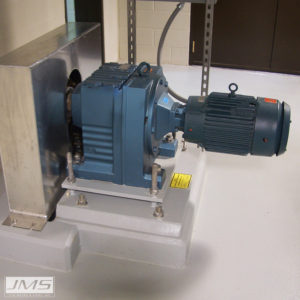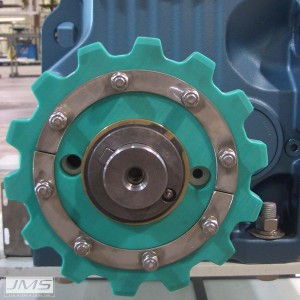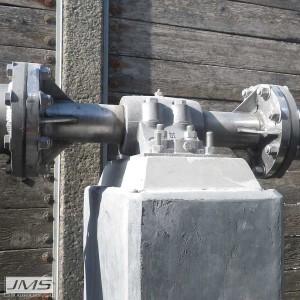JMS has designed and installed Mega-FLOC (Horizontal Paddle Wheel Flocculator)s for over 50 years. In that time JMS has made improvements to the design of the Mega-FLOC to improve its life span and performance. JMS has made improvements to the design of the Mega-FLOC (Horizontal Paddle Wheel Flocculator) to improve its life span and performance. Each change has increased efficiency and lowered the flocculator maintenance requirements. Learn more about the innovation JMS has done with the Mega-FLOC (HPWF) by watching the video or reading about the improvements below.
Mega-FLOC (Horizontal Paddle Wheel Flocculator) Key Features

Drive Assembly
Optimal gear motor horsepower requirements determined using the designed velocity gradient, system efficiencies, and safety factors. Available in three different arrangements; wet chain, dry chain, and direct coupled.

Drive Sprocket
JMS drive sprockets are designed and fabricated with stainless steel sprocket hub and UHMW-PE sprocket teeth. Our component selection ensures the drive sprocket works optimally and accurately engages the drive chain.

Driven Sprocket
JMS designed the driven sprocket arrangements using a split machined cast iron sprocket hub with segmental UHMW-PE teeth to accurately engage the drive chain to give the maximum chain tension does not exceed the working load of the chain.

Shaft Connections
JMS shaft connections are the standard for all flocculators. These connections utilize bored blind flanges with special welds for added strength. Each flange is grooved to the correct diameter and surface milled to parallel for strength and proper alignment.

Bearing Assembly
The JMS bearing assembly is designed to be durable and have a low life cycle cost. JMS Mega-FLOC (HPWF) uses submerged journal bearings that are manufactured with split cast stainless steal housings with UHMW-PE liners which allow for water lubrication.
Kerry Dissinger has been employed by JMS for the last 10 years, and currently holds the position of Vice President. Prior to receiving a BS degree in Electro Mechanical Engineering, Kerry served for 3 years as a US Army Paratrooper stationed at Fort Bragg, NC. He also served 6 years in the Pennsylvania Army National Guard. Kerry’s nearly 20 years of experience in the water and wastewater industry includes 10 years at Brentwood Industries where he was mentored by the esteemed Dr. McDowell. With his strong background in the water and wastewater process, particularly sedimentation, he is focused on continued growth and innovation, holding several active patents for JMS products. One of Kerry’s favorite sayings is: It’s not about ideas; it’s about making ideas happen.
